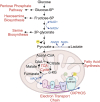Beyond glucose and Warburg: finding the sweet spot in cancer metabolism models
- PMID: 40603611
- PMCID: PMC12118702
- DOI: 10.1038/s44324-024-00017-2
Beyond glucose and Warburg: finding the sweet spot in cancer metabolism models
Abstract
Advances in cancer biology have highlighted metabolic reprogramming as an essential aspect of tumorigenesis and progression. However, recent efforts to study tumor metabolism in vivo have identified some disconnects between in vitro and in vivo biology. This is due, at least in part, to the simplified nature of cell culture models and highlights a growing need to utilize more physiologically relevant approaches to more accurately assess tumor metabolism. In this review, we outline the evolution of our understanding of cancer metabolism and discuss some discrepancies between in vitro and in vivo conditions. We describe how the development of physiological media, in combination with advanced culturing methods, can bridge the gap between in vitro and in vivo metabolism.
© 2024. The Author(s).
Conflict of interest statement
Competing interests: The authors declare no competing interests.
Figures



Similar articles
-
Factors that influence parents' and informal caregivers' views and practices regarding routine childhood vaccination: a qualitative evidence synthesis.Cochrane Database Syst Rev. 2021 Oct 27;10(10):CD013265. doi: 10.1002/14651858.CD013265.pub2. Cochrane Database Syst Rev. 2021. PMID: 34706066 Free PMC article.
-
Interventions for promoting habitual exercise in people living with and beyond cancer.Cochrane Database Syst Rev. 2018 Sep 19;9(9):CD010192. doi: 10.1002/14651858.CD010192.pub3. Cochrane Database Syst Rev. 2018. PMID: 30229557 Free PMC article.
-
Electronic cigarettes for smoking cessation.Cochrane Database Syst Rev. 2022 Nov 17;11(11):CD010216. doi: 10.1002/14651858.CD010216.pub7. Cochrane Database Syst Rev. 2022. Update in: Cochrane Database Syst Rev. 2024 Jan 8;1:CD010216. doi: 10.1002/14651858.CD010216.pub8. PMID: 36384212 Free PMC article. Updated.
-
Electronic cigarettes for smoking cessation.Cochrane Database Syst Rev. 2021 Sep 14;9(9):CD010216. doi: 10.1002/14651858.CD010216.pub6. Cochrane Database Syst Rev. 2021. Update in: Cochrane Database Syst Rev. 2022 Nov 17;11:CD010216. doi: 10.1002/14651858.CD010216.pub7. PMID: 34519354 Free PMC article. Updated.
-
Systemic pharmacological treatments for chronic plaque psoriasis: a network meta-analysis.Cochrane Database Syst Rev. 2017 Dec 22;12(12):CD011535. doi: 10.1002/14651858.CD011535.pub2. Cochrane Database Syst Rev. 2017. Update in: Cochrane Database Syst Rev. 2020 Jan 9;1:CD011535. doi: 10.1002/14651858.CD011535.pub3. PMID: 29271481 Free PMC article. Updated.
Cited by
-
Metabolomics in Breast Cancer: From Biomarker Discovery to Personalized Medicine.Metabolites. 2025 Jun 23;15(7):428. doi: 10.3390/metabo15070428. Metabolites. 2025. PMID: 40710528 Free PMC article. Review.
References
-
- Martinez-Reyes, I. & Chandel, N. S. Cancer metabolism: looking forward. Nat. Rev. Cancer21, 669–680 (2021). - PubMed
Publication types
Grants and funding
LinkOut - more resources
Full Text Sources
Miscellaneous
